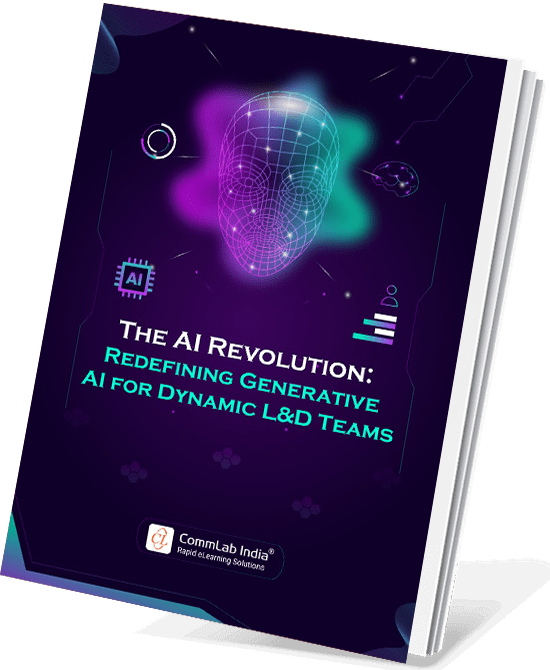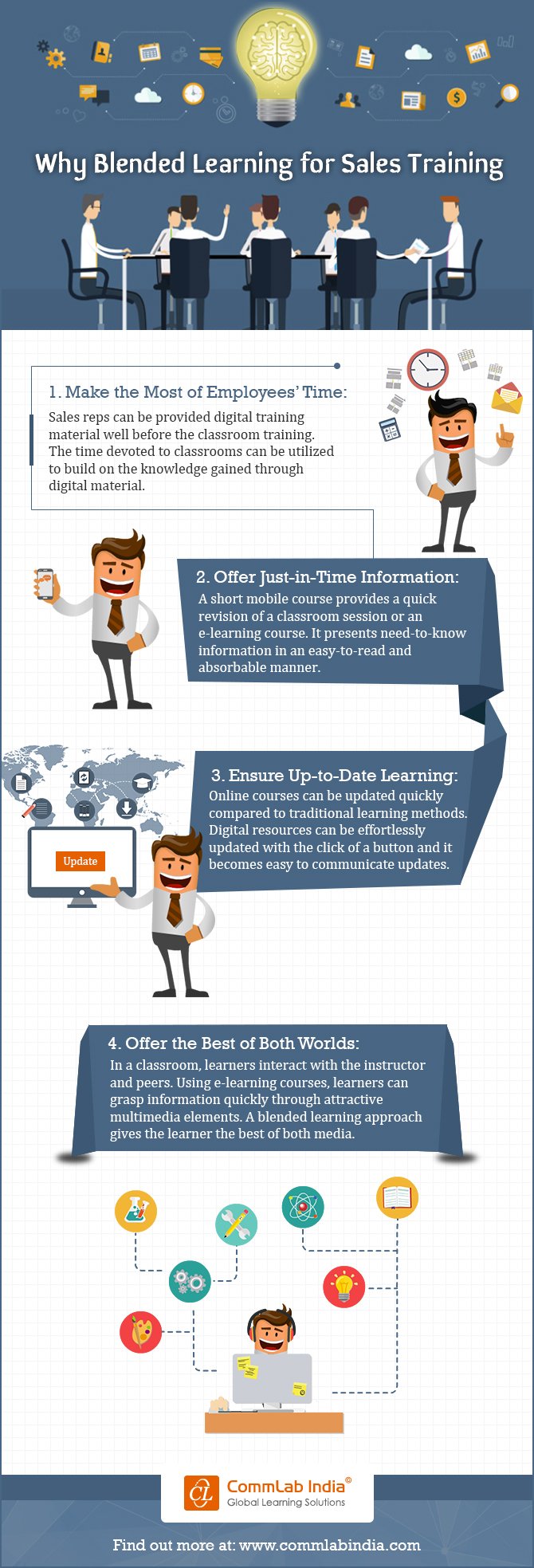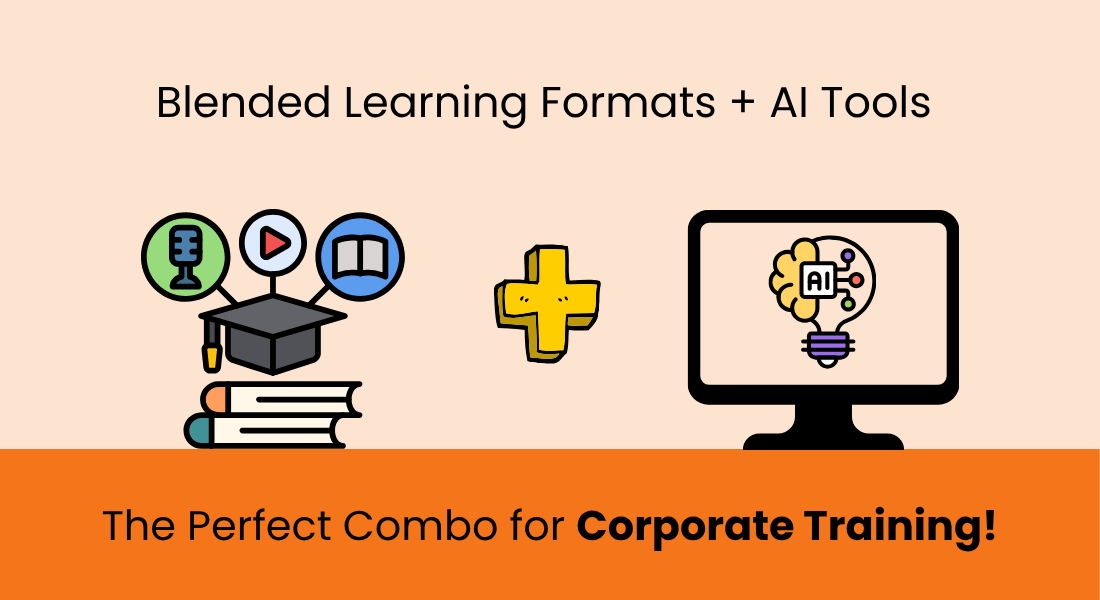5 Best Practices for Effective Blended Learning

In the world of corporate training, blended learning has emerged as a powerful, reliable strategy. It combines the perks of traditional face-to-face instruction and online learning. While the benefits of blended learning are substantial, its effectiveness hinges on thoughtful implementation and adherence to best practices. In this blog, we'll understand what blended learning is, its benefits in corporate training, best practices to follow, and lastly, the use case of blended learning in the corporate setting.
→ Download eBook: Impact of Generative AI on L&D Teams
Table of Contents
- What is Blended Learning?
- What Are the Benefits of Blended Learning in Corporate Training?
- What Are the Use Cases of Blended Learning in the Corporate World?
- What Are the 5 Best Practices of Blended Learning?
What is Blended Learning?
Blended learning is an approach that combines traditional in-person classroom instruction with online learning components. By integrating digital resources, such as virtual lectures and interactive activities, with face-to-face training, blended learning provides a flexible and personalized learning experience.

This method aims to leverage the strengths of both methods, offering learners the benefits of traditional classroom interaction while incorporating the flexibility and accessibility of online resources. The combination of in-person and digital elements allows for a more effective learning experience, catering to diverse learning styles and fostering greater learner engagement.
What Are the Benefits of Blended Learning in Corporate Training?
Blended learning in corporate training offers several benefits. Here’s a quick overview of some of the notable ones.

Now let’s check each of these benefits in detail.
- Flexibility and Accessibility: The online element in blended learning enables employees to access training materials at their convenience. This helps accommodate diverse schedules and locations.
- Cost-Efficiency: Integrating online components reduces costs associated with traditional classroom training, such as travel expenses, venue rentals, and printed materials.
- Higher Learner Engagement: Combining interactive components of online learning with face-to-face sessions enhances engagement by offering a variety of learning activities and multimedia resources.

Redefining Generative AI for Dynamic L&D Teams
Discover how Generative AI is breaking boundaries and empowering L&D Teams
- Why leverage Generative AI for L&D?
- What training managers should know about generative AI
- Ethical conundrums for Generative AI: Use cases
- Future prospects of Generative AI
What Are the Use Cases of Blended Learning in the Corporate World?
Blended learning finds application in various scenarios, optimizing training outcomes and employee development. Some prominent use cases include:
Onboarding Programs
Blended learning can enhance the onboarding process by combining traditional orientation sessions with online modules covering company policies, values, and basic job skills. This ensures a standardized introduction to the organization while allowing new hires to progress at their own pace.
Watch this video to explore the different blended learning ideas for onboarding training.
Product and Process Training
For companies introducing new products, services, or processes, blended learning is a gift. It helps ensure that the employees acquire the necessary knowledge and skills efficiently. The combination of in-person demonstrations, workshops, and online modules offers the flexibility to revisit online resources as needed.
Soft Skills Training
Developing soft skills can come in handy for your employees with blended learning. While in-person workshops provide opportunities for interactive activities and role-playing, online modules reinforce concepts and provide self-assessment tools.

Compliance Training
Leveraging blended learning for compliance training proves beneficial when employees need to understand and adhere to regulations and policies. You can leverage face-to-face sessions to cover topics that deserve special attention and assign online modules for topics that employees just need to be aware of. Moreover, online lessons can be beneficial for learners to review and refresh their understanding of various topics.
Sales Training
Blended learning is well-suited for sales training programs. In-person sessions can focus on product knowledge and sales techniques, while online modules provide resources for ongoing learning, such as market updates, competitor analyses, and customer relationship management. Here’s an infographic to help you understand the importance of blended learning in sales training in a better manner.
Technical Skills Training
Blended learning is effective for imparting technical skills. By combining the hands-on experience such as labs, workshops, and instructor-led sessions with online modules and simulations, learners can gain a comprehensive understanding of complex technical concepts.
What Are the 5 Best Practices of Blended Learning?
Want to Design Impactful Blended Learning?
Here are the best practices to keep in mind:
- Start with Clear Learning Objectives
- Design Your Course Intentionally
- Use Technology Strategically
- Focus on Learner Engagement
- Leverage Data Analytics
Start with Clear Learning Objectives
To ensure a successful blended learning experience, make sure you set the foundation right by defining learning objectives clearly. You must carefully identify what your learners need to achieve. This will assist you in a thoughtful selection of a harmonious blend of online and offline activities to support these goals.
Design Your Course Intentionally
Blended learning is not about haphazardly combining digital and traditional resources. A well-designed blended learning course requires intentional planning, considering how each component contributes to the overall learning experience. Deliberate course design ensures a seamless integration of both mediums, optimizing their combined impact on learner understanding.
Use Technology Strategically
While technology is a cornerstone of blended learning, not all tools are created equal. Trainers must carefully select technology that aligns with their learning objectives and meets learners' needs. The strategic use of technology should enhance the learning experience, rather than being incorporated for its own sake.
Focus on Learner Engagement
Engagement is the key to effective learning in a blended environment. Both online and offline activities should captivate learners’ attention and encourage active participation rather than passive consumption of information. Fostering engagement creates a learning environment that stimulates curiosity and deepens understanding.
Leverage Data Analytics
Tap into the power of data to consistently refine and improve your blended learning course. You can use online tools and assessment methods, like quizzes and surveys, to track your learners' progress, engagement, etc. It will allow you to identify areas for improvement. By leveraging data-driven insights, you can adapt and optimize your approach to better meet your learners' needs.
Wrapping It Up!
When it comes to modern-day training needs, blended learning is an effective approach. It offers significant scope for improving the training experience by combining offline and online learning methods. And to make the most of it, you need to keep in mind the best practices discussed in the blog. Moreover, in today’s digital world, artificial intelligence (AI) can also contribute significantly to enhancing and improving your blended learning programs. Curious to know how? Check out our eBook on AI revolution which explains how generative AI empowers L&D teams. So what are you waiting for? Get ready to enjoy the blend of learning and success!






